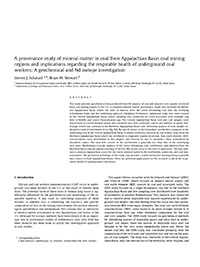Mining Publication: A provenance study of mineral matter in coal from Appalachian Basin coal mining regions and implications regarding the respirable health of underground coal workers: A geochemical and Nd isotope investigation
Original creation date: May 2012
This study presents geochemical data produced from the analysis of coal and adjacent rock samples retrieved from coal mining regions in the U.S. to examine mineral matter provenance. Study sites included the Northern Appalachian Basin, where the units of interest were the Lower Kittanning Coal bed, the overlying Columbiana Shale, and the underlying paleosol (Allegheny Formation). Additional study sites were located in the Central Appalachian Basin, where sampling was conducted on strata associated with multiple coal beds of Middle and Lower Pennsylvanian age. The Central Appalachian Basin rock and coal samples were much lower in overall mineral matter and contained very little carbonate (calcite and siderite) or pyrite mineralogy, which was common at the Northern Appalachian Basin sites. Elemental analysis of rock samples indicated a trend of enrichment in Ca, Mg, Mn, Na, and K cations in the immediate overburden compared to the underlying rock in the Central Appalachian Basin. A similar trend was observed in coal related strata from the Northern Appalachian Basin which was attributed to epigenetic marine incursions. Rare earth element (REE) concentrations were determined in the samples, and showed Eu and Ce anomalies when normalized by chondritic values. The total REE content of the overburden is generally less than that of the underlying rock units. Neodymium isotopic analysis of the Lower Kittanning coal, overburden, and paleosol from the Northern Basin indicate partial resetting of the Sm–Nd system close to the time of deposition. The data indicate a common Appalachian source for the clastic mineral matter in the overburden, underclay, and coal mineral matter. The geochemical findings of this study may provide a viable method for distinguishing respirable dust sources in both Appalachian Basins. There are potential applications for this research to aid in the respiratory health of underground coal miners.
Authors: SJ Schatzel, BW Stewart
Peer Reviewed Journal Article - May 2012
NIOSHTIC2 Number: 20040526
Int J Coal Geol 2012 May; 94:123-136
See Also
- The Availability of Primary Copper in Market Economy Countries: A Minerals Availability Appraisal
- Benchmarking Longwall Dust Control Technology and Practices
- Determining the Spatial Variability of Personal Sampler Inlet Locations
- Effect of Coal Type and Oxyfuel Combustion Parameters on Pulverised Fuel Ignition
- Methane Diffusion Parameters for Sized Coal Particles: A Measuring Apparatus and Some Preliminary Results
- Preventing Falls of Ground in Coal Mines With Exceptionally Low-Strength Roof: Two Case Studies
- Reservoir Engineering Considerations for Coal Seam Degasification and Methane Control in Underground Mines
- Rock and Minerals Make up Your World: Rock and Mineral 10-Specimen Kit Companion Book
- Rock Dusting Considerations in Underground Coal Mines
- Safer Mine Layouts for Underground Stone Mines Subjected to Excessive Levels of Horizontal Stress
- Content source: National Institute for Occupational Safety and Health, Mining Program


 ShareCompartir
ShareCompartir
